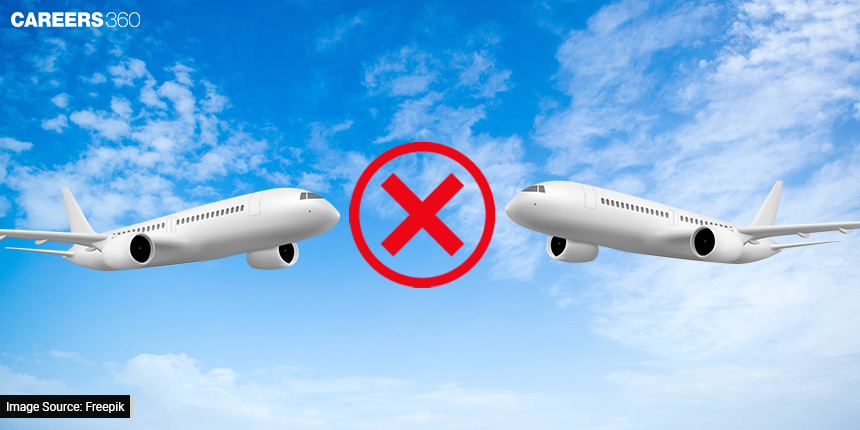Why Don’t Aeroplanes Collide Mid-Air?
In our modern world, it’s not just the cities that are bustling, the skies above have marked a noticeable increase in air traffic. Aeroplanes navigate intricate flight paths, seamlessly, avoiding collisions effortlessly. With the increasing volume in air traffic, one might wonder how planes manage to avoid collisions and navigate safely through the sky.

In this article, we have discussed the complex mechanisms that prevent mid-air collisions of aeroplanes. From air traffic control's vigilance to advanced radar systems and collision avoidance technology, we explore the careful coordination of flight planning and route separation. Embark with us on a journey to understand the engineering, technology, and human expertise that make air travel one of the safest modes of transportation in the world.
Also Read | Which Concepts Of Physics Are Used While Flying?
Air Traffic Control
Air Traffic Control (ATC) is the backbone of aviation safety. Ground-based control centres are responsible for monitoring and managing the movement of aircraft in designated airspace. Through real-time monitoring and coordination, ATC controllers provide precise instructions to pilots, ensuring safe distances are maintained between aircraft. They assign specific altitudes, headings, and routes to flights, preventing potential conflicts and collisions. By tracking the positions of aircraft using radar and communication systems, ATC controllers are able to detect any potential conflicts and take immediate corrective actions, such as altering flight paths or altitudes, to ensure that planes are adequately separated.
This proactive approach, coupled with their ability to communicate with pilots and relay critical information, is the cornerstone of air traffic control's effectiveness in preventing mid-air collisions and ensuring the safety of the people onboard the flights.
Controlled Airspace
Airspace is divided into different classes, each with its own rules and regulations. These classes determine the types of flights that are allowed and the level of control imposed by air traffic controllers. The most controlled airspace is found around busy airports and high-traffic routes. Controlled airspace plays a crucial role in preventing mid-air collisions by establishing a structured and regulated environment for aircraft operations. Airspace is designated and monitored by ATC to ensure that planes are separated both horizontally and vertically. ATC allocates specific altitudes and flight paths to different aircraft, reducing the risk of conflicts and ensuring safe separation. Controlled airspace enhances situational awareness for pilots and controllers alike, facilitating effective communication and coordination to avoid potential collisions.
Radar and Transponders
These systems play a vital role in tracking aircraft movements and avoiding mid-air collisions by providing crucial data for ATC and collision avoidance systems. Radar systems emit radio waves that bounce off aircraft, allowing controllers to accurately track their positions and movements in real-time. Transponders on aircraft respond to radar signals by transmitting information about the aircraft's identity, altitude, and speed. This information enables air traffic controllers to maintain a comprehensive picture of the airspace and the positions of nearby aircraft. This combined radar-transponder technology enhances situational awareness for both controllers and pilots, enabling precise coordination and effective avoidance of mid-air collisions.
Also Read | Cricket's Sweet Spot: Understanding The Physics Of Bat-Ball Collisions
Collision Avoidance Systems
Modern aircrafts are equipped with sophisticated collision avoidance systems, the most common being the Traffic Alert and Collision Avoidance System (TCAS). TCAS is a critical technology that plays a pivotal role in preventing mid-air collisions between aeroplanes. It continuously monitors the airspace around an aircraft using data received from nearby aircraft's transponders. When the system detects another aircraft on a potential collision course, it issues advisories to both pilots. In case the threat of a collision becomes imminent, TCAS provides Resolution Advisories (RAs), instructing the pilots to either climb or descend in order to create vertical separation between the two aircraft. By providing real-time situational awareness and guidance, TCAS acts as a last-resort safety net, enabling pilots to take swift and coordinated action to avoid mid-air collisions in even the most complex and congested airspace scenarios.
Flight Planning and Route Separation
Before a flight takes off, pilots and dispatchers collaborate on meticulous flight plans. These plans take into account various factors, such as air traffic congestion, weather conditions, and airspace restrictions. Flight planning and route separation are crucial components of aviation safety that help prevent mid-air collisions between aeroplanes. Flight planning involves ultra-careful coordination between pilots and dispatchers to create optimal flight paths, considering factors such as air traffic congestion, weather conditions, and airspace restrictions. These plans are designed to minimise the likelihood of aircraft intersecting with each other, ensuring safe distances are maintained.
Route separation involves assigning different flight paths and altitudes to aircraft travelling in the same airspace, further reducing the risk of collision. By strategically navigating aeroplanes along distinct routes and maintaining vertical separation, the aviation industry ensures that planes can coexist safely in the sky, minimising any sort of mid-air conflicts.
The safety of air travel is the result of a comprehensive and complicated network of measures designed to prevent mid-air collisions. From the vigilant watch of air traffic controllers to the radar systems that never rest, and the meticulous flight planning that crafts precise routes, every element harmonises to prevent the unimaginable. While the skies might seem chaotic from a distance, the aviation industry's commitment to safety and the rigorous implementation of these measures ensure the safety of air travellers in the vast expanse of the sky.
Also Read | Quantum Numbers: What Are The Rules for Electron Arrangement?
Applications for Admissions are open.
As per latest syllabus. Physics formulas, equations, & laws of class 11 & 12th chapters
JEE Main Important Chemistry formulas
Get nowAs per latest syllabus. Chemistry formulas, equations, & laws of class 11 & 12th chapters
JEE Main high scoring chapters and topics
Get nowAs per latest 2024 syllabus. Study 40% syllabus and score upto 100% marks in JEE
JEE Main Important Mathematics Formulas
Get nowAs per latest syllabus. Maths formulas, equations, & theorems of class 11 & 12th chapters
